Recent national and state polling shows that the election may be breaking in Barack Obama’s direction. With the so-called Palin "bounce" behind us, and the economy front and center with just over a month until election day, now is a good time to take stock of the race. The race is starting to firm up, and barring an October Surprise or a McCain solo bombing run over Waziristan, the current polling trends should hold up.
With that in mind, I have used the new Pollster charting features to create charts (see below) for the battleground states. The customizations I have made to the composite polling results are:
- I am using more sensitive smoothing to give newer polls more weight. This may result in skewed trendlines if the newer polls are found to be outliers – but I am willing to risk it for our purposes.
- I have dropped ARG and Zogby polls. If you are fan of these two pollsters, you won’t like this, but I have found that throwing a dart at the wall is just as reliable as these two pollsters.
- I am only looking at poll numbers starting September 1.
With these changes, Obama is now leading McCain nationally 49.5% to 43.7%.
Barack Obama can pretty safely count on 197 electoral votes from the following states (and DC): California, Connecticut, Washington DC, Delaware, Hawaii, Iowa, Illinois, Massachusetts, Maryland, Maine, New Jersey, New York, Oregon, Rhode Island, Vermont and Washington.
John McCain can safely count on 174 electoral votes from the following states: Alabama, Alaska, Arizona, Arkansas, Georgia, Idaho, Kansas, Kentucky, Louisiana, Mississippi, Missouri, Montana, Nebraska, North Dakota, Oklahoma, South Carolina, South Dakota, Tennessee, Texas, Utah, West Virginia and Wyoming.
That leaves 13 battleground states worth 167 electoral votes that will determine this election. These states are Colorado, Florida, Indiana, Michigan, Minnesota, North Carolina, New Hampshire, New Mexico, Nevada, Ohio, Pennsylvania, Virginia and Wisconsin.
Of these battleground states, Obama is expected to hold Michigan, Minnesota, New Hampshire, Pennsylvania and Wisconsin for a total of 62 electoral votes. If he holds these states he would only need 11 more electoral votes to win the election. These are targeted to come from 2 of the 3 southwestern states in the battleground.
Of the states Obama must hold, he is beginning to pull away in Michigan and Wisconsin. He is ahead and moving further up slowly in Pennsylvania. However, even though he is still up, he is losing ground in both New Hampshire and Minnesota.
Of the remaining battleground states, Obama is ahead and pulling away in Colorado and New Mexico. If he can hold New Hampshire and Minnesota, these two states with a total of 14 electoral votes will give him the election. Obama holds a slim lead in Nevada and is trending up while McCain’s numbers are plummeting fast. Nevada’s 5 electoral votes look likely to go to Obama.
Obama is also ahead and trending upwards in both Virginia and North Carolina. It looks like he has a genuine chance of winning in Virginia. A victory in North Carolina would be stunning, but it appears that it may be within reach. Obama has a chance to pick up 13 and perhaps even 28 electoral votes from these two states.
Obama is behind but gaining in Florida while support for McCain appears to be slipping. A state that had looked to be solidly in McCain’s column now appears to be a genuine tossup. Obama is behind in Ohio, even though he is showing some improvement in the polls. However, it seems to me, with McCain’s support holding steady, Ohio will probably be a bridge too far for Obama.
The remaining state, reliably red Indiana (which had recently crept into the battleground) promises to remain red, in spite of better performance by Obama in the polls. Obama is behind in the polls and there is little indication that he will be able to pass McCain here.
The battleground polls bode very well for an Obama victory in November. With the southwestern states and Virginia he is poised to carry the election by 291 electoral votes to 247. If Obama flips North Carolina and Florida, McCain could be facing a 333 to 205 electoral thumping in November. My sense is that Obama will win North Carolina but lose Florida and win with a 306 to 212 electoral vote margin.
All this of course is just a parlor game since the only poll that matters is the one on November 4th. Still, looking at the current state of the electoral map, the McCain camp must be hard at work on their next political stunt.
—————————————–
National numbers: Obama 49.5%, McCain 43.7%
Colorado numbers: Obama 50.3%, McCain 44.8%
New Mexico numbers: Obama 53%, McCain 42%
Nevada numbers: Obama 45.9%, McCain 45.5%
Virginia numbers: Obama 49.7%, McCain 45.3%
North Carolina numbers: Obama 48.3%, McCain 44.8%
New Hampshire numbers: Obama 46.2%, McCain 44.7%
Pennsylvania numbers: Obama 48%, McCain 44.2%
Michigan numbers: Obama 48.7%, McCain 43.4%
Minnesota numbers: Obama 46.3%, McCain 45.5%
Wisconsin numbers: Obama 49.4%, McCain 43.5%
Florida numbers: Obama 46.5%, McCain 47.7%
Ohio numbers: Obama 46.6%, McCain 47%
Indiana numbers: Obama 45.9%, McCain 48.6%




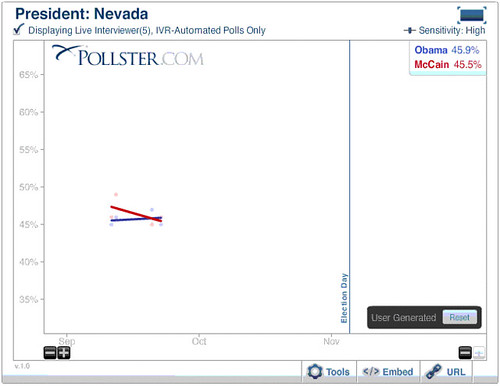
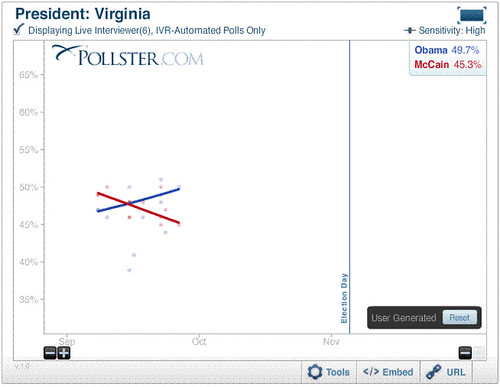
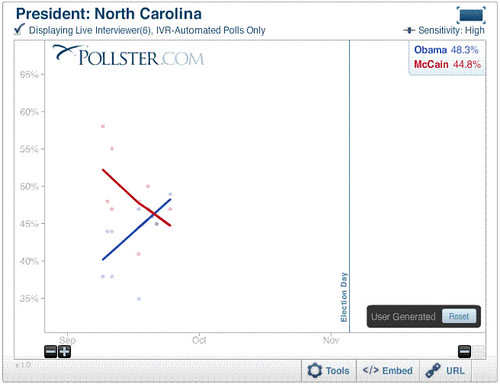
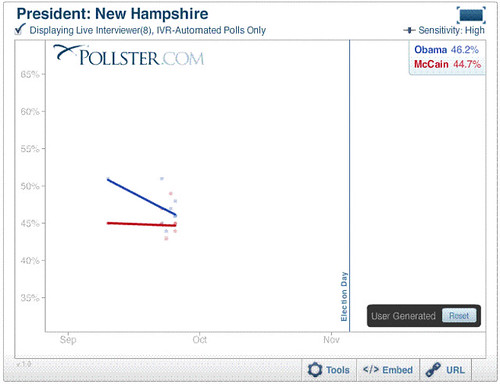
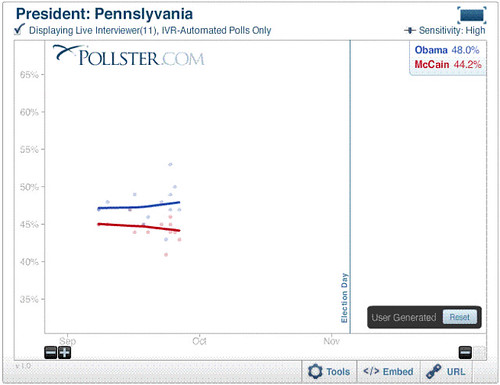

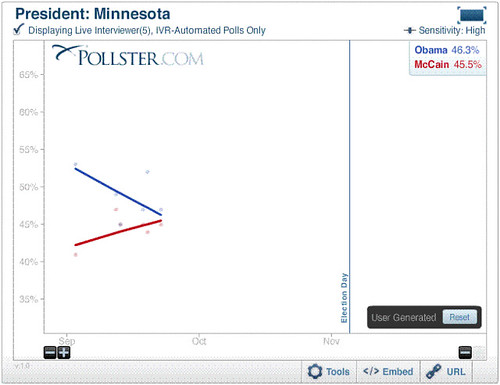
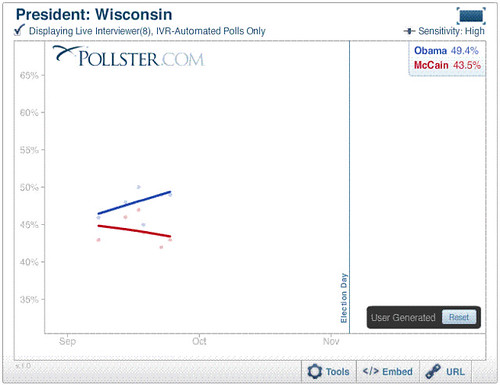
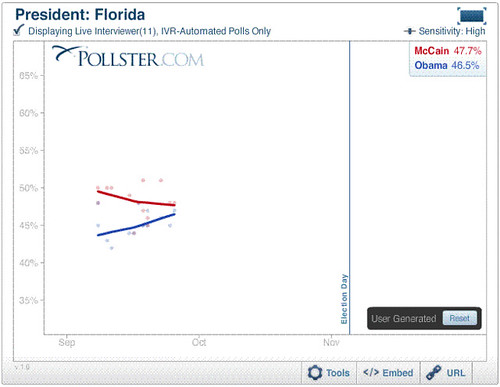

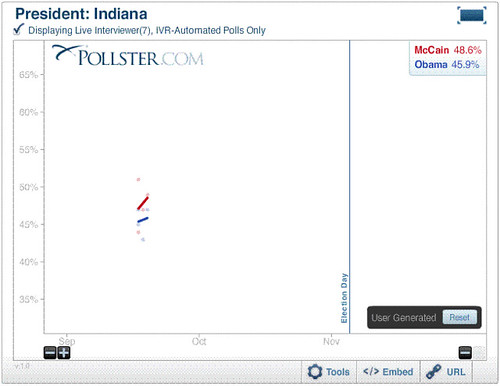









The real issue is not how well Obama or McCain might do state-by-state, but that we shouldn’t have battleground states and spectator states in the first place. Every vote in every state should be politically relevant in a presidential election. And, every vote should be equal. We should have a national popular vote for President in which the White House goes to the candidate who gets the most popular votes in all 50 states.
The National Popular Vote bill would guarantee the Presidency to the candidate who receives the most popular votes in all 50 states (and DC). The bill would take effect only when enacted, in identical form, by states possessing a majority of the electoral vote — that is, enough electoral votes to elect a President (270 of 538). When the bill comes into effect, all the electoral votes from those states would be awarded to the presidential candidate who receives the most popular votes in all 50 states (and DC).
Because of state-by-state enacted rules for winner-take-all awarding of their electoral votes, recent candidates with limited funds have concentrated their attention on a handful of closely divided “battleground” states. In 2004 two-thirds of the visits and money were focused in just six states; 88% on 9 states, and 99% of the money went to just 16 states. Two-thirds of the states and people have been merely spectators to the presidential election.
Another shortcoming of the current system is that a candidate can win the Presidency without winning the most popular votes nationwide.
The National Popular Vote bill has passed 21 state legislative chambers, including one house in Arkansas, Colorado, Maine, North Carolina, and Washington, and both houses in California, Hawaii, Illinois, New Jersey, Maryland, Massachusetts, Rhode Island, and Vermont. The bill has been enacted by Hawaii, Illinois, New Jersey, and Maryland. These four states possess 50 electoral votes– 19% of the 270 necessary to bring the law into effect.
See http://www.NationalPopularVote.com